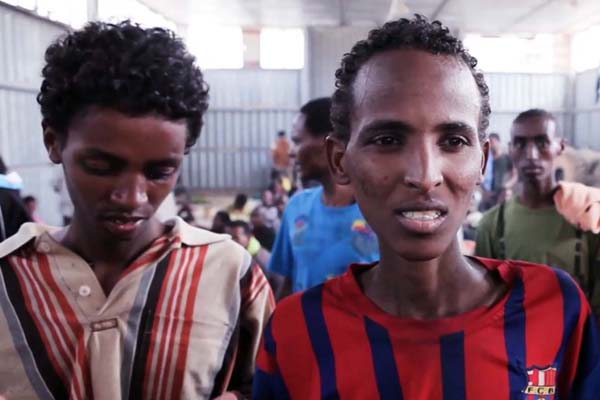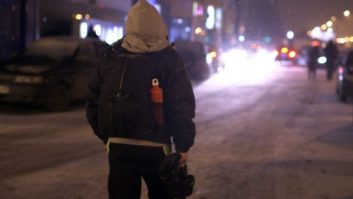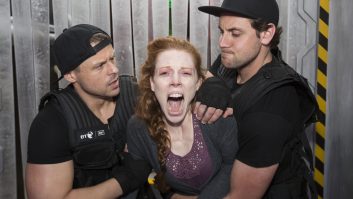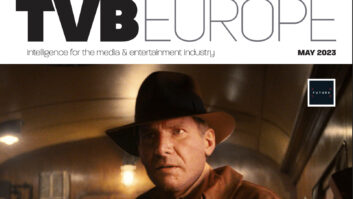
The Rory Peck Awards 2016 saw nine experienced finalists emerge from 101 entries, submitted by freelance journalists from 36 nations. UK nationals were responsible for 20 entries across the three Sony-sponsored categories, and another five entries saw UK names partner American, Israeli, Afghan, French and Mexican journalists on projects. American nationals fielded nine entries, with French journalists totalling seven.
BAFTA was the venue for the first awards night back in 1995, and a single prize saw just 15 entries competing. Since then, the Rory Peck Trust has become one of the most effective and best-loved small charities in the world, thanks to the support of the world’s big players in the news business, and a constantly committed staff.
James Mates, chair of the judging panel for news and Europe editor, ITV News, says, “We faced unprecedented quality. Reducing this to just three finalists was almost impossible. In the dim and distant past, some of the material you would get from freelancers and through agencies was sometimes of mixed quality. That is no longer the case.
“One of the biggest changes we have seen in our industry is the improvement in the quality of both journalism and video,” Mates adds.
When commenting on (Yemeni) Nabil Hassan’s news finalist The Battle for Aden, a brilliant report of anti-rebel militiamen battling Houthi rebels for possession of Aden, Mates is succinct: “News organisations are desperate for this stuff.
“It is less than possible for Western reporters and cameramen to operate at all, so we completely rely – and the world completely relies – on people like Nabil shooting material so we have some idea of what is going on, some sense of what’s driving the conflict, how serious it is, and how many victims there are.”
Hassan is clear about casualties: 18 Yemeni journalists had been killed trying to do what he had done for AFP.
A lot of it was on the spot
Greek national Will Vassilopoulos won the Rory Peck award for news for his story Fear and Desperation: Refugees and Migrants Pour into Greece. This follows a good percentage of the 860,000 migrants who landed in Greece last year.
“It was very challenging for numerous reasons, but the one I would like to address is the emotional toll it had on all of us working in the field,” he says. “What I found most difficult in the film was sticking a camera in front of their faces when they were at their most vulnerable, when they landed on an island, all of them terrified, and then going north to the Macedonian borders, where the conditions were absolutely horrific.”
Vassilopoulos filmed with utmost respect for the migrants, and treated them with dignity. He shot from October 2015 to March 2016. He says, “It’s a story that needed to be told. It’s not only very important for the Middle East, but it is also how Europe is being shaped by the migration crisis.
“This was not about how many hours that I shot, it’s all about how many hours that went out to clients. At least a dozen hours went to outlets through Agence France-Presse,” he adds. “A lot of this footage is rushes for the news agency, so it is not necessarily following people from entry to end. A lot of it was on the spot, so I could tell many stories. I would find particular people, gain their trust, build a rapport with them, and try and tell the stories at that location.”
A failed state on the doorstep of Europe
Italian journalist Marco Salustro collected the award for news features with another migration tale called Libya’s Migrant Trade: Europe or Die, which was shot for Vice News in June 2015.
Salustro, who was applauded for delivering the sense of fear, insecurity and lack of hopethat dogged all of the migrants he encountered, says, “The militia I filmed thought my work was useful for them, because they wanted to have recognition from the government. They were quite happy to show me how they were treating the migrants.”
He shot 20 hours worth of material, which was cut back to 30 minutes for the winning title.
“I had been to Libya seven times before this film and I worked on another film on this issue a few months before, so I had the contacts and everything was quite easy for me,” he explains. “This is a big story. The Western media is full of migrant and Islamic State stories, but there are lots of problems in Libya that are unresolved and we are facing a country that is on the verge of collapse. In a short time, we will have a failed state on the doorstep of Europe, and migration will be unanswerable.”
Some of his wonderful shots are from inside the detention centre run by the militia. “I was given half an hour there and just left the camera rolling while the migrants told their stories, without translation as there was no time,” says Salustro.
Migrant family though a lens
German filmmaker Marcel Mettelsiefen won the Sony Impact award for current affairs with his brilliant entry Children on the Frontline: The Escape, which is part two of a story he told in 2013 about the children of a rebel commander in Aleppo.
Shot in Syria, Turkey and Germany until April 2016, and seen on Channel 4’s Dispatches;his winning story follows the family after ISIS captured the father. The mother, three daughters and a son escape from Aleppo to Turkey, and then onto Germany and a new life.
The judges say that it is very rare for a filmmaker to be so immersed in his subject: the consequence being that the Mettelsiefen camera was totally invisible.
He says, “This took three years of my life. Documentary filmmaking is one of the most unbelievable experiences if you are able to gain peoples’ trust, to squeak into their lives. This makes our profession so beautiful. I managed to gain the trust of one of the most inspiring families I have ever met.”
Journalists were beaten up
One of the finalists in news features, Lottie Gammon, and one in the Sony Impact category from Paul Salahadin Refsdal, emphasised the crucial aspects of securing the working environment, and also being lucky.
In shooting Tracking down Macedonia’s Refugee Kidnap Gangs for Channel 4 News, Gammon had reporter Ramita Naval for company. The film hangs on the testimonies of two refugees who escaped.
“We knew about the coordinates of a house where refugees were being kidnapped, but didn’t know what would happen when we got there,” she says. “The refugees were locked in, and there were definitely weapons present.”
“We had excellent support on the ground. We were working with two Macedonian journalists and an ethnic Albanian freelancer from the nearby villages, so that secured the locals for us. Journalists were known to be beaten up going into those places, but the village was angry about the gang operating there,” says Gammon.
“The gang themselves did not know we were coming and we had no idea how they would react,” she adds. “I did film openly but it was quite difficult, especially in the border area controlled by the gangs. There was a point when I tried to film and they got very angry and started chasing us. Luckily, another ‘higher up’ trafficking gangster told them to back off, otherwise we could have been in serious trouble.”
Once the story was exposed, the Macedonian authorities raided the house and 200 people were freed, with several traffickers arrested.
“It led to Macedonia easing its restrictions on refugees passing through, which resulted in nine months when people were able to pass through safe from the kidnappers. But they closed the borders in the spring and I heard in Serbia that the traffickers are back up and running.”
Gammon and Naval shot relentlessly for eight days, for an 11-minute film. “I very much like working in a team,” says Gammon. “You are a lot safer. You need another pair of eyes, especially when you are shooting.”
Four tons of explosives
Refsdal’s film Dugma: The Button is about suicide bombers, and was shot in Syria in the hosting company of the al-Qaida affiliate Jabhat al Nusra.
“I started filming and asked for one of the ‘martyrdom seekers’ as they call them. I met a Saudi man who was supposed to blow himself up within two weeks, when I would be back in Norway,” says Refsdal. “When I returned for my second trip, he was still alive. On my first trip I also met a British convert who was on the list, and when I went back, he was getting married, so I decided to concentrate on these people and produce a story about them.”
He emphasised that he was studying fellow humans. “They have their doubts, they change their mind. They volunteer, and it’s a long list because there were few suicide operations being ordered,” says Refsdal. “Even on the night of driving a truck bomb at the Syrian army, the bomber can decide he cannot do it. They have a reserve on the list. This is not Islamic State. They don’t target civilians.”
How did he get accepted? “I started the project in 2013, and spent about 16 weeks inside the rebel-controlled area until I got permission. I had 20 hours of raw footage, but it was not as much as I wanted. After I spent a month with them on my last trip, they said, ‘Now your film is finished. Go home’.”
In one scene, a bomber sits in a truck cab explaining the system of two buttons he has to push. How dangerous was that?
“We got bombed several times. In the film, standing there with the truck, you know it is loaded with four tons of explosives, and the Syrian army started shelling the area. That was a bit hairy,” says Refsdal.
It is really tough out there
Gammon and Refsdal spent time plotting safety plans, but Rory Peck Trust director Tina Carr speaks from the experience of sending out over 200 assistance grants in 2016, to freelancers and their families.
“We are proud to help freelancers. Many are being targeted by companies, by factions, gangsters, and anyone who wants to control the agenda,” she says. “It is really tough out there for them, and it is getting tougher.”
On the issue of the growing population of exiled and displaced freelance journalists, she adds, “There are more than ever because of repression, bullying and beatings. What’s changed is that this is now happening closer to home, happening in countries that we do not consider as countries where we have that kind of problem.”
The trust has managed to stretch the impact of its work through links to partner organisations. It wants to stay small to stay personal. “We just want to be able to do what we do better, and I would like to do that with staff that work five days a week rather than three,” says Carr.
The camera vanishes
Michael Harrit, marketing director, media solutions, with Sony PSE, saw a lot of the best entries in his capacity as chair of the Sony Impact Award judges.
“The storytelling was much more in focus this year. Every year has its own vintage character, and it’s getting better, and more varied,” he says. “The camera is almost disappearing in the way stories are told, which is a sign of both good journalism and good camera work.
“In the case of the Ben Steele film The Children Who Beat Ebola, where he follows two brothers, a lot of the shots are at the height of the children, and you are more closely relating to these characters,” he added. “You can still relate to the Ebola story through the humanity in survival. There were a lot of emotional moments present this year.”
Harrit observed that the one topic of refugees had been covered from so many angles. What is it that freelancers need in the way of technology?
“A combo of very high picture quality, low light performance, and ergonomics. There are many positions that are difficult to shoot, so thinking about how to hold the camera in difficult positions is important,” he says. “It is always a balance between being small and losing out on some quality or flexibility. If it gets too big you lose out on flexibility, and may miss some shots. But for Sony, it’s not a question of selling cameras. It is all about supporting the Rory Peck Trust.
“Freelancers live a dangerous life and no other organisation supports them in terms of advice and education, and support in difficult personal situations.”
Every person has to assess risk
Ben Steele was a finalist in the Sony Impact category, with the judges noting, “It takes incredible skill to make such a sensitive and nuanced film in those conditions.”
He says, “I would not go into an active war zone, but I was comfortable going to the Ebola hot spot in West Africa. Every person has to assess risk and decide what you are comfortable with, and for me that project felt perfectly acceptable.”
The third finalist in new features was The Road to Fallujah by Ayman Oghanna and Warzer Jaff. The other finalist in news was Waad Al Kateeb with A Life in the Day of Aleppo. Waad is the working name of a 24-year old Syrian mother married to a doctor. She sent a message from Eastern Aleppo, which read, “I am still watching what is happening and filming. I still have hope. We have been under siege for 107 days.”
Oghanna and Jaff joined the Iraqi Special Forces as they fought to remove ISIS from towns and cities in Anbar Province. It took 18 months to secure the ride.
“Being freelancers allowed us to spend the time to develop relationships and trust. We were probably the first ever people to have the access to the Iraqi military, and now, if you look at the situation in Mosul, everyone is trying to do what we did,” says Oghanna.
Jaff confirmed that they had spent five weeks in battle zones with ISIS during which they secured 900 GBs of footage.
For the first time, the Martin Adler Award for heroic levels of support to freelancers went to a woman. Angel istek Alcu, who lives and works in the Turkish city of Diyarbakir, is a journalist, fixer, guide and translator.




